- Home
- Oliver Sacks
The Mind's Eye Page 2
The Mind's Eye Read online
Page 2
When I asked Lilian how she felt about herself and her situation, she said, “I think I am dealing with it very well, most of the time … knowing it is not getting better, but only slowly worse. I’ve stopped seeing neurologists. I always hear the same thing.… But I am a very resilient person. I don’t tell my friends. I don’t want to burden them, and my little story is not very promising. A dead end.… I have a good sense of humor. And that’s it, in a nutshell. It is depressing, when I think of it—frustrations daily. But I have many good days and years ahead.”
After Lilian left, I was unable to find my medical bag—a black bag with some similarities (I now remembered) to one of the several bags she had brought. Going home in the taxi, she realized that she had taken the wrong bag when she saw a red-tipped object sticking out of it (my long, red-tipped reflex hammer). It had attracted her attention, by its color and shape, when she saw it on my desk, and now she realized her mistake. Returning, breathless and apologetic, to the clinic, she said, “I am the woman who mistook the doctor’s bag for her handbag.”
Lilian had done so badly on the formal tests of visual recognition that I had difficulty imagining how she managed in daily life. How did she recognize a taxi, for example? How could she recognize her own home? How could she shop, as she told me she did, or recognize foods and serve them on a table? All this and much more—an active social life, traveling, going to concerts, and teaching—she did by herself when her husband, who was also a musician, went to Europe for weeks at a time. I could get no idea of how she accomplished this from seeing her dismal performance in the artificial, impoverished atmosphere of a neurology clinic. I had to see her in her own familiar surroundings.
· · ·
The following month, I visited Lilian at home, home being a pleasant apartment in upper Manhattan where she and her husband had lived for more than forty years. Claude was a charming, genial man about the same age as his wife. They had met as music students at Tanglewood nearly fifty years earlier and had pursued their musical careers in tandem, often performing onstage together. The apartment had a friendly, cultured atmosphere, with a grand piano, a great many books, photographs of their daughter and of friends and family, abstract modernist paintings on the wall, and mementos of their trips on every available surface. It was crowded—rich in personal history and significance, I imagined, but a nightmare, a complete chaos, for someone with visual agnosia. This, at least, was my first thought as I entered, negotiating my way between tables full of knickknacks. But Lilian had no difficulty with the clutter and threaded her way confidently through the obstacles.
Since she had had such difficulty on the drawing-recognition test, I had brought a number of solid objects with me, wondering if she would do better with these. I started with some fruit and vegetables I had just bought, and here Lilian did surprisingly well. She instantly identified “a beautiful red pepper,” recognizing it from across the room; a banana, too. She was momentarily uncertain whether the third object was an apple or a tomato, though she soon decided, correctly, on the former. When I showed her a small plastic model of a wolf (I keep a variety of such objects, for perceptual testing, in my medical bag), she exclaimed, “A marvelous animal! A baby elephant, perhaps?” When I asked her to look more closely, she decided it was “a kind of dog.”
Lilian’s relative success in naming solid objects, as opposed to drawings of them, again made me wonder whether she had a specific agnosia for representations. The recognition of representations may require a sort of learning, the grasping of a code or convention, beyond that needed for the recognition of objects. Thus, it is said, people from primitive cultures who have never been exposed to photographs may fail to recognize that they are representations of something else. If a complex system for the recognition of visual representations must be specially constructed by the brain, this ability might be lost through damage to that system by a stroke or disease, just as the learned understanding of writing, say, or any other acquired ability may be lost.
I followed Lilian into the kitchen, where she set about taking the kettle off the stove and pouring boiling water into the teapot. She seemed to navigate her crowded kitchen well, knowing, for instance, that all the skillets and pots were hung on hooks on one wall, various supplies kept in their regular places. When we opened the refrigerator and I quizzed her on the contents, she said, “O.J., milk, butter on the top shelf—and a nice sausage, if you’re interested, one of those Austrian things … cheeses.” She recognized the eggs in the fridge door and, when I asked her, counted them correctly, moving her finger from egg to egg as she did so. I could see at a glance that there were eight—two rows of four—but Lilian, I suspect, could not perceive the eightness, the gestalt, easily and had to enumerate the eggs one by one. And the spices, she said, were “a disaster.” They all came in identical red-topped bottles, and, of course, she could not read the labels. So: “I smell them! … And I call for help some of the time.” With the microwave oven, which she used often, she said, “I don’t see the numbers. I do it by feel—cook, try, see if it needs a bit more.”
Though Lilian could scarcely recognize anything in the kitchen visually, she had organized it in such a way that mistakes rarely, if ever, occurred, utilizing a sort of informal classification system instead of a direct perceptual gnosis. Things were categorized not by meaning but by color, by size and shape, by position, by context, by association, somewhat as an illiterate person might arrange the books in a library. Everything had its place, and she had memorized this.
Seeing how Lilian inferred the character of the objects around her in this way, using color, above all, as a marker, I wondered how she would do with objects of similar appearance, like the fish knives and the steak knives, which looked almost the same. This was a problem, she confessed, and she often confused them. Perhaps, I suggested, she could use an artificial marker, a little green dot for the fish knives, a red one for the steak knives, so that she could see the difference at a glance. Lilian said she had already thought about this but was not sure she wanted to “flaunt” her problem to others. What would her guests think of color-coded cutlery and dishes, or a color-coded apartment? (“Like a psychological experiment,” she said, “or an office.”) The “unnaturalness” of such an idea disturbed her, but if the agnosia got worse, she agreed, she might need it.
In some cases where Lilian’s categorization system did not work, such as using the microwave, she could operate by trial and error. But if objects were not in their place, major difficulties could appear. This showed itself startlingly at the end of my visit. The three of us—Lilian, Claude, and I—had sat down at the dining room table. Lilian had laid the table, put out biscotti and cakes, and now brought in a steaming pot of tea. She chatted as we ate, but retained a certain watchfulness, monitoring the position and movement of every dish, tracking everything (I later realized), so that it did not get “lost.” She got up to take the empty dishes into the kitchen, leaving only the biscotti, which she saw that I especially liked. Claude and I chatted for a few minutes—our first talk alone—pushing the plate of biscotti between us.
When Lilian came back, and I packed my bag and prepared to go, she said, “You must take the rest of the biscotti with you”—but now, bizarrely, she could not find them, and became upset, almost frantic, at this. They were right on the table in their dish, but since the dish had been moved she no longer knew where they were, or even where to look. She seemed to have no strategy for looking. She was, however, quite startled to see my umbrella on the table. She failed to recognize it as an umbrella, noticing only that something curved and twisted had appeared—and wondered, for a half-serious moment, if it was a snake.
Before I left, I asked Lilian to go to the piano, asked if she would play something for me. She hesitated. It was clear that she had lost a good deal of her confidence. She started beautifully, on a Bach fugue, but broke off, apologetically, after a few bars. Seeing a volume of Chopin mazurkas on the piano, I asked about those, and,
encouraged, she closed her eyes and played two of the Opus 50 mazurkas without faltering, and with great brio and feeling.
She told me afterward that the printed music was just “lying around,” saying, “It throws me off to see the score, people turning pages, my hands, or the keyboard,” and that, in such circumstances, she might make mistakes, especially with her right hand. She had to close her eyes and perform nonvisually, using only her “muscle memory,” and her fine ear.
What could I say about the nature and progress of Lilian’s strange disease? It had clearly advanced somewhat since her neurological examination three years before, and there were hints—though no more than hints—that her problems might no longer be purely visual. In particular, she occasionally had difficulty naming objects even when she recognized them, and would speak of a “thingmy” when she could not get the word.
I had ordered a new MRI to compare with her earlier one, and it showed that there was now some shrinkage of the visual areas on both sides of the brain. Was there any sign of real damage elsewhere? It was difficult to tell, although I suspected that there might have been some shrinkage in the hippocampi, too—parts of the brain crucial for the registration of new memories. But the damage was still largely confined to the occipital and occipitotemporal cortex, and it was clear that the rate of advance was very slow.
When I discussed these MRI findings with Claude, he stressed that in speaking with Lilian I should avoid certain terms, above all the frightening label of Alzheimer’s disease. “It’s not Alzheimer’s disease, is it?” he said. Clearly, this had been much on their minds.
“I’m not sure,” I said. “Not in the ordinary sense. One should see it as something rarer—and more benign.”
· · ·
Posterior cortical atrophy, PCA, was first formally described by Frank Benson and his colleagues in 1988, although it has undoubtedly existed, unrecognized, for much longer. But Benson et al.’s paper provoked a rush of recognition, and dozens of cases have now been described.
People with PCA preserve elementary aspects of visual perception, such as acuity or the ability to detect movement or color. But they tend to experience complex visual disturbances—difficulties reading or recognizing faces and objects, occasionally even hallucinations. Their visual disorientation may become profound: some patients get lost in their own neighborhoods or even in their own homes; Benson called this “environmental agnosia.” Other difficulties commonly follow: left-right confusion, difficulty in writing and calculation, even an agnosia for one’s own fingers, a tetrad of problems sometimes called Gerstmann’s syndrome. Sometimes patients with PCA may be able to recognize and match colors but unable to name them, a so-called color anomia. More rarely, there can be a difficulty in visual targeting and tracking movements.
In contrast to these difficulties, memory, intelligence, insight, and personality tend to be preserved until late in the course of the disease. Every patient described by Benson, he writes, “could present his or her own history, was aware of current events, and showed considerable insight into his or her predicament.”
Although PCA is clearly a degenerative brain disease, it seems quite different in character from the commoner forms of Alzheimer’s, where gross changes in memory and thinking, in the comprehension and use of language, and often in behavior and personality tend to occur, and insight into what is happening (perhaps mercifully) is generally lost early on.
In Lilian’s case, the course of the disease seemed to have been relatively benign, for even nine years after her first symptoms, she did not get lost in her own home or neighborhood.
I could not help making a comparison, as Lilian herself had, with my patient Dr. P., “the man who mistook his wife for a hat.” Both of them were highly gifted professional musicians; both developed severe visual agnosias, while remaining remarkably intact in many other ways; and both had discovered or developed ingenious ways around their problems, so that it was possible for them to keep teaching at the highest level in music colleges, despite what might appear to be quite devastating disabilities.
The actual ways in which Lilian and Dr. P. coped with their illnesses were very different, though—a reflection in part of the severity of their symptoms, and in part of differences in temperament and training. Dr. P. was already in grave trouble when I saw him, barely three years after his initial symptoms. He had not only visual difficulties but tactile ones, too—he grasped his wife’s head and mistook it for a hat. He showed a sort of levity or indifference, and little insight into the fact that he was ill, and he often confabulated to make up for the fact that he could not identify what he was seeing. This was in strong contrast to Lilian, who, nine years after her first symptoms, had no substantial problems outside her visual ones, was still able to travel and teach, and showed acute insight into her own condition.
Lilian could still identify objects by inference, using her intact perception of color, shape, texture, and movement, along with her memory and intelligence. Dr. P. could not. He could not, for instance, identify a glove by sight or by feel (despite being able to describe it in almost absurdly abstract terms, as “a continuous surface infolded on itself [with] five outpouchings, if this is the word … a container of some sort?”)—until, by accident, he got it onto his hand. He was, in general, almost wholly dependent on doing things, on action, on flow. And singing, which for him was the most natural, irrepressible activity in the world, allowed him to bypass his agnosia to some extent. He had all sorts of songs that he would hum or sing: dressing songs, shaving songs, action songs. Music, he had found, could organize his activities, his daily life.1 This was not the case with Lilian. Her great musicality was also preserved, but it did not play a comparable role in her daily life; it was not, for her, a strategy for dealing with agnosia.
A few months later, in June of 1999, I again visited Lilian and Claude in their apartment—Claude was just back from his weeks in Europe, and Lilian, I gathered, had been moving freely within a four-block radius of their apartment, going to her favorite restaurant, shopping, doing errands. When I arrived, I saw that Lilian had been sending cards to her friends all over the world—there were envelopes addressed to Korea, to Germany, to Australia, to Brazil, scattered all over the table. Her alexia, clearly, had not diminished her correspondence, though the names and addresses sometimes straggled over the envelope. She seemed to be managing well in her own apartment, but how did she deal with shopping and the challenges of a busy New York neighborhood, even her own?
“Let’s go out, let’s wander,” I said. Lilian immediately started singing “Der Wanderer”—she loves Schubert—and then the elaboration of this in the Wanderer Fantasy.
In the elevator, she was greeted by some neighbors. It was not clear to me whether she recognized them visually or by their voices. She instantly recognized voices, sounds of all sorts; indeed, she seemed hyperattentive here, as she was to colors and shapes. They had assumed a special importance as cues.
She had no difficulty crossing the street. She could not read the “Walk” and “Don’t Walk” signs, but she knew their relative position and color; knew, too, that she could walk when the sign was blinking. She pointed out a synagogue on the corner opposite; other shops she identified by shapes or colors, as with her favorite diner, which had alternating black and white tiles.
We went into a supermarket and got a cart—she headed instantly to the alcove where these were. She had no difficulty in finding the fruit and vegetable section, or in identifying apples, pears, carrots, yellow peppers, and asparagus. She could not at first name a leek but said, “Is it a cousin of an onion?” and then got the missing word, “leek.” She was puzzled by a kiwifruit, until I let her handle it. (She thought it “delightfully furry, like a little mouse.”) I reached up for an object hanging above the fruit. “What is this?” I asked. Lilian squinted, hesitated. “Is it edible? Paper?” When I let her touch it, she burst into somewhat embarrassed laughter. “It’s an oven glove, a pot holder,” she said.
“How could I be so silly?”
When we moved to the next section, Lilian called out, “Salad dressings on the left, oils on the right,” in the manner of a department-store elevator operator. She had obviously mapped the entire supermarket in her head. Wanting a particular tomato sauce, one of a dozen different brands, she picked it out because it had “a deep-blue rectangle and below that a yellow circle” on its label. “Color is of the essence,” she emphasized again. This is her most immediately visible cue, recognizable when nothing else is. (For that reason, fearing we might be separated, I had dressed entirely in red for our visit, knowing that it would allow her to spot me instantly if we did.)
But color was not always enough. If confronted with a plastic container, she might have no idea whether it contained peanut butter or cantaloupe. Often, she found that the simplest strategy was to bring in a used can or carton and ask someone for help in matching it.
As we left the market, she accidentally crashed the shopping cart into a pile of shopping baskets to her right. Such accidents, when they happen, are always to the right, because of her impaired visual awareness to this side.
Some months later, I arranged to see Lilian in my own office rather than at the clinic, where she had come before. She arrived promptly, having made her way to Greenwich Village from Penn Station. She had been in New Haven the night before, where her husband had given a concert, and he had seen her onto a train that morning. “I know Penn Station like the back of my hand,” she said, so she did not have problems there. But outside, in the melee of people and traffic, she noted, “there were many moments when I had to ask.” When I inquired about how she had been doing, she said her agnosia was getting worse. “When you and I went to the market together, there were many things I could recognize easily. Now, if I want to buy the same things, I have to ask people.” In general, she had to ask others to identify objects for her, or to help her if there were awkward steps, sudden changes of level, or irregularities in the ground. She depended more on touch and on hearing (to make sure, for instance, that she was facing the right way). And she depended increasingly on her memory, her thinking, her logic and common sense to help negotiate what would otherwise be—visually—an unintelligible world.

 Uncle Tungsten
Uncle Tungsten Oaxaca Journal
Oaxaca Journal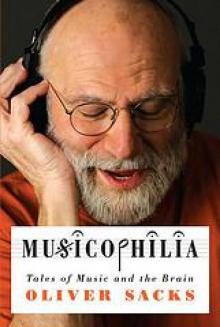 Musicophilia
Musicophilia The man who mistook his wife for a hat
The man who mistook his wife for a hat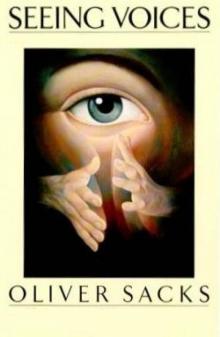 1989 - Seeing Voices
1989 - Seeing Voices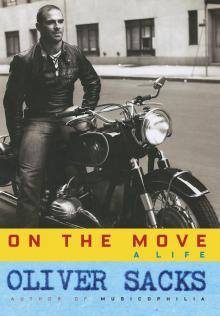 On the Move: A Life
On the Move: A Life 1996 - The Island of the Colorblind
1996 - The Island of the Colorblind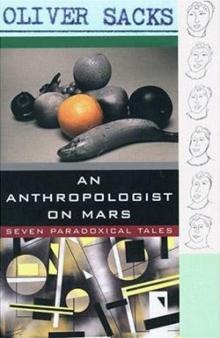 An Anthropologist on Mars: Seven Paradoxical Tales
An Anthropologist on Mars: Seven Paradoxical Tales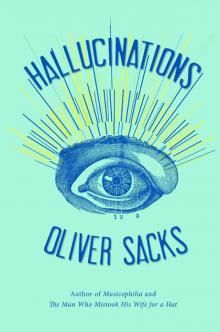 Hallucinations
Hallucinations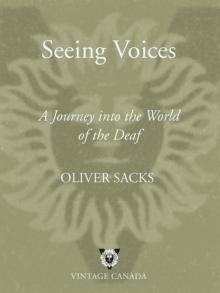 Seeing Voices
Seeing Voices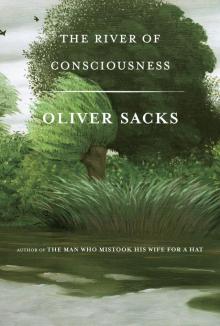 The River of Consciousness
The River of Consciousness Vintage Sacks
Vintage Sacks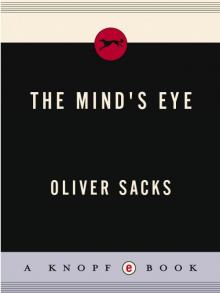 The Mind's Eye
The Mind's Eye Everything in Its Place
Everything in Its Place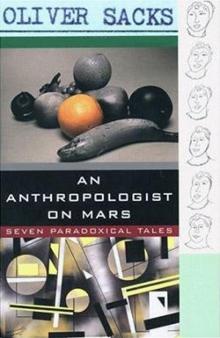 An Anthropologist on Mars (1995)
An Anthropologist on Mars (1995) Uncle Tungsten: Memories of a Chemical Boyhood (2001)
Uncle Tungsten: Memories of a Chemical Boyhood (2001)